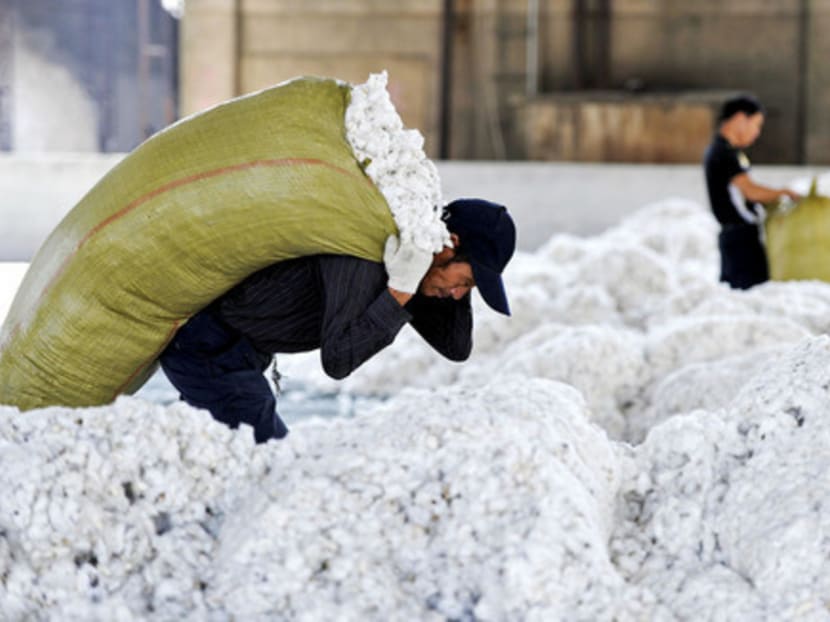China’s GM crops fail to bear fruit
BEIJING — In a speech a year ago, President Xi Jinping backed China’s development of genetically modified (GM) crops as a means of strengthening food security. But even he hedged a little, warning: “Be bold in research, careful in promotion.”

A worker carries a sack of cotton at a cotton purchasing station in Anhui province. Most cotton grown in China is genetically modified to discourage the bollworm. PHOTO: REUTERS
BEIJING — In a speech a year ago, President Xi Jinping backed China’s development of genetically modified (GM) crops as a means of strengthening food security. But even he hedged a little, warning: “Be bold in research, careful in promotion.”
China’s pro-GM camp is now counting on the President’s support to unblock a bureaucratic stalemate that has stalled development of the crops by the world’s largest food consumer.
After waves of state funding, researchers have developed a number of crops and are now only waiting for the green light to commercialise them. But approval will be slow in coming as long as public opinion — and more importantly, officialdom — remains firmly anti-GM.
“After that speech, open opposition to GM has quietened down,” says botanist Xu Zhihong, the retired president of Peking University. “There’s still some, but you find fewer online rants.”
In China, food safety is an emotional topic. Distrust of Chinese-produced products runs high in the urban middle class after a series of scandals, the most serious of which was the 2008 contamination of baby milk with melamine. At least six babies died from the contaminated formula and tens of thousands were hospitalised.
China took a step towards breaking the logjam on the approval of new imported strains of GM crops this month, when it agreed to allow imports of a type of corn developed by Syngenta. United States trading giant Cargill sued Syngenta after it was forced early this year to reroute China-bound cargoes containing the seed, which had not been approved by the Chinese authorities.
Nevertheless, the pace of approval for imported GM strains has slowed considerably. That frustrates growers and traders in the US, Brazil and Argentina, who hesitate to plant strains they cannot ship to the world’s biggest buyer of grains.
“China’s society is changing,” said Mr Zhu Zhen, a scientist at the Institute of Genetics and Developmental Biology, a division of the Chinese Academy of Sciences. He was surprised by the opposition when he developed a strain of GM rice. More than 10 years later, it is still awaiting approval. “Strong social resistance means GM can’t be rolled out quickly,” he complained.
Official opposition comes from agriculture industry groups, especially north-eastern soya growers and seed marketers who fear increased competition, nationalists who are worried about the influence of Western agri-tech giants, and environmental groups including Greenpeace.
Agriculture Minister Han Changbin tried to ease concerns when he told a journalist in March: “I, too, eat food processed with GM materials.” For China, that was a sensational admission.
Mr Han was referring to Chinese cooking oil, the vast majority of which is made from imported GM soya beans. His ministry has followed up with measures for promoting GM food to the public, which include a ban on food makers branding their products “GM-free”.
“You have to understand that the debate over this is not mature in China, it’s very volatile,” said one of the country’s top journalists covering GM. “Xi Jinping’s talk has emboldened scientists to talk about GM, otherwise they would just hide in their shells.”
Most cotton grown in China is genetically modified to discourage the bollworm. Papayas, as well as some poplar trees — grown for wood and as windbreaks on the flat northern plains — are also largely GM. Strains of GM plants approved in the 1980s were based on techniques originally developed in the US, although they are considered Chinese intellectual property.
Even if there was national consensus on GM, Chinese strains are not ready for widespread planting, despite Mr Xi’s vision that China occupy the “commanding heights” of the industry. For one thing, the traditional division between research academies and businesses works against commercialisation.
And for all the talk of food security, the most promising crops in China’s line-up are ornamental plants. The main reason is not science, but bureaucracy: They only need approval from the Forestry Ministry.
THE FINANCIAL TIMES





